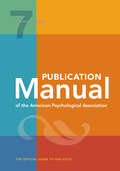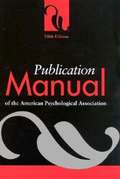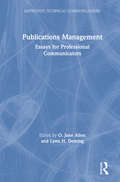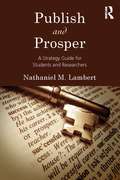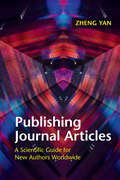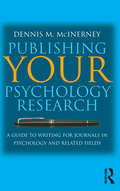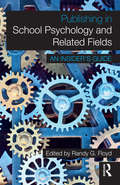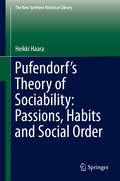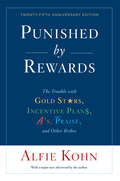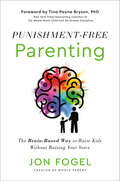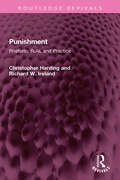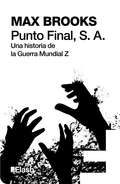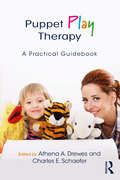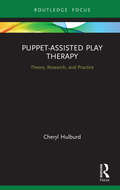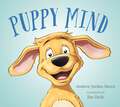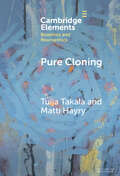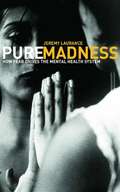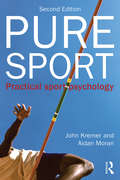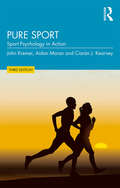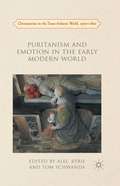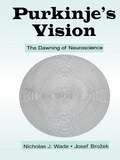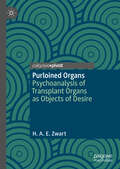- Table View
- List View
Publication Manual (OFFICIAL) 7th Edition of the American Psychological Association
by American Psychological AssociationA WALL STREET JOURNAL, USA TODAY, AND PUBLISHERS WEEKLY BESTSELLER. The newest official release of the Publication Manual of the American Psychological Association, Seventh Edition includes four different formats—spiral-bound and tabbed, paperback, hardcover, and ebook, all of which are in full color. It is the official source for APA Style. With millions of copies sold worldwide in multiple languages, the Publication Manual of the American Psychological Association, Seventh Edition is the style manual of choice for writers, researchers, editors, students, and educators in the social and behavioral sciences, natural sciences, nursing, communications, education, business, engineering, and other fields. Known for its authoritative, easy-to-use reference and citation system, the Publication Manual also offers guidance on choosing the headings, tables, figures, language, and tone that will result in powerful, concise, and elegant scholarly communication. It guides users through the scholarly writing process—from the ethics of authorship to reporting research through publication. The seventh edition is an indispensable resource for students and professionals to achieve excellence in writing and make an impact with their work. The seventh edition has been thoroughly revised and updated to reflect best practices in scholarly writing and publishing. All formats are in full color, with a new tabbed spiral version Improved ease of navigation, with many additional numbered sections to help users quickly locate answers to their questions Resources for students on writing and formatting annotated bibliographies, response papers, and other paper types as well as guidelines on citing course materials Dedicated chapter for new users of APA Style covering paper elements and format, including sample papers for both professional authors and student writers New chapter on journal article reporting standards (JARS) that includes updates to reporting standards for quantitative research and the first-ever qualitative and mixed methods reporting standards in APA Style Updated chapter on bias-free language guidelines for writing about people with respect and inclusivity in areas including age, disability, gender, participation in research, racial and ethnic identity, sexual orientation, socioeconomic status, and intersectionality More than 40 new sample tables and figures Expanded guidance on ethical writing and publishing practices, including how to ensure the appropriate level of citation, avoid plagiarism and self-plagiarism, and navigate the publication process More than 100 new reference examples covering periodicals, books, audiovisual media, social media, webpages and websites, legal resources, and more Guidelines that support accessibility for all users, including simplified reference, in-text citation, and heading formats as well as additional font options
Publication Manual of the American Psychological Association (5th edition)
by American Psychological AssociationIn 1999 the APA Publications and Communications Board authorized work to begin on this fifth edition of the Publication Manual.
Publication Manual of the American Psychological Association (6th Edition)
by American Psychological AssociationThe style manual of choice for writers, editors, students, and educators in the social and behavioral sciences, this updated "Publication Manual" provides invaluable guidance on all aspects of the writing process, from the ethics of authorship to the word choice that best reduces bias.
Publications Management: Essays for Professional Communicators (Baywood's Technical Communications)
by O. Jane Allen Lynn H Deming"Publications Management: Essays for Professional Communicators" is a collection of essays designed for use in academic programs in technical and professional communication and for communication professionals in the workplace. The contributors include publications managers in the workplace and academics who teach in technical and professional communication programs. Their multiple perspectives offer a broad introduction to some of the important issues publications.
Publish and Prosper: A Strategy Guide for Students and Researchers
by Nathaniel M. LambertIntended to help readers succeed in academia by increasing their scholarly productivity, this book provides strategies for getting articles published quickly in reputable research journals. Rather than focusing on the basics of writing about results, this unique guidebook provides tips on how to approach research, maintain motivation, maximize productivity, and overcome common pitfalls so as to become productive scholars. The strategies reviewed will help readers successfully navigate through graduate school, get a good job, receive grants and promotions, and make important contributions to their field. Written in a breezy style, this book offers case studies, examples, and personal experiences that illustrate the themes of the chapters. Introductions and summaries and key points help to highlight the most critical concepts reviewed in each chapter. Chapter exercises encourage self-reflection and/or the application of the strategies introduced in that chapter. Self-assessment questions in Appendix A help readers pinpoint their strengths and weaknesses.A tracking chart, referred to throughout, provides an effective way to follow the progress of several manuscripts that are at different stages. An interactive version of the chart is available at www.pepstrategies.com along with the time diary and the chapter and self assessment exercises. Although a young scholar, Nathaniel Lambert has an impressive track record. He already has over 50 papers published in research journals. This book reviews winning strategies practiced by the author and additional insights based on conversations with top producing scholars. By diligently applying this book’s core strategies, you too can publish and prosper! Part 1 describes issues related to prioritizing one’s research such as the importance of selecting the right topic and how to use goals and deadlines to enhance motivation. Tips for enhancing efficiency are provided in Part 2 including how to improve writing efficiency, juggle several projects simultaneously, reduce wasting time, and select the best collaborators. Part 3 explores productivity pitfalls and how to avoid them. Tips on how to avoid burnout and distractions and handle rejection are explored. Part 4 provides unique tips to apply at various stages of one’s academic career: undergraduate, graduate, and professional. Practical appendices provide an opportunity to determine one’s strengths and weaknesses keep track of projects, and expand one’s knowledge using the recommended reading list. Intended as a reference for students who are planning to attend graduate school and/or pursue an academic career, this book is ideal for professional development and/or research methods courses taught in the behavioral, social, health, and life sciences and for researchers and professionals looking to increase their publication productivity.
Publishing Journal Articles: A Scientific Guide for New Authors Worldwide
by Catherine Snow Zheng YanJournal publication and grant writing are two core professional skills for new scholars today. However, systematic training is not typically offered in graduate programs worldwide. This book equips readers with the current scientific knowledge by providing a concise introduction to the science of journal article publication. The overall structure generally matches the curriculum of a graduate course and each chapter features a learning sequence based on Daniel Kahneman's intuitive judgement theory. The volume analyzes the intuitive thoughts of new authors from a variety of countries, uses over fifty real-life cases, and focuses on core concepts from nearly 100 research articles. It provides scientific advice for new authors, junior researchers, and graduate students to publish their scholarly work and advance their academic careers.
Publishing Your Psychology Research: A guide to writing for journals in psychology and related fields
by Dennis M McInerneyDennis McInerney's Publishing Your Psychology Research has bridged a much needed gap in the research process literature, providing a well-oiled treaty from both insider and outsider perspectives as to what it takes to become a credible and published author.Dr. Shawn Van EttenDirector of Institutional ResearchHerkimer County Community CollegeState University of New YorkDo you want to publish your psychology research in the 'best' journals? Whether you are new to the game or a seasoned researcher, Dennis McInerney shows you how to maximise your chances of publication from the very beginning of your research project. Richly illustrated with tips and examples, Publishing Your Psychology Research demystifies the publication process. It explains how to design your research to ensure it has potential for publication, and how to write up your results into an effective article. It outlines what journal editors are looking for, how to select the appropriate journals to approach, and how to react to reviewers' feedback.Publishing Your Psychology Research is an essential handbook for anyone interested in building a reputation as a researcher in their chosen field of psychology.
Publishing in School Psychology and Related Fields: An Insider's Guide
by Randy G. FloydPublishing in School Psychology and Related Fields aims to help students, early career professionals, and seasoned scholars alike better understand the process of peer-review and publishing in journals, books, and other professional-oriented forums. Edited by a former editor of the Journal of School Psychology and containing chapters from insiders who have operated as productive authors, reviewers, and editors, this informative new resource contains practical and invaluable advice for anyone looking to increase their scholarly productivity and jump start their career.
Pufendorf’s Theory of Sociability: Passions, Habits and Social Order (The New Synthese Historical Library #77)
by Heikki HaaraThis book centres on Samuel Pufendorf’s (1632–1694) moral and political philosophy, a subject of recently renewed interest among intellectual historians, philosophers and legal scholars in the English-speaking world. Pufendorf’s significance in conceptualizing sociability in a way that ties moral philosophy, the theory of the state, political economy, and moral psychology together has already been acknowledged, but this book is the first systematic investigation of the moral psychological underpinnings of Pufendorf’s theory of sociability in their own right. Readers will discover how Pufendorf’s psychological and social explanation of sociability plays a crucial role in his natural law theory. By drawing attention to Pufendorf’s scattered remarks and observations on human psychology, a new interpretation of the importance of moral psychology is presented. The author maintains that Pufendorf’s reflection on the psychological and physical capacities of human nature also matters for his description of how people adopt sociability as their moral standard in practice. We see how, since Pufendorf’s interest in human nature is mainly political, moral psychological formulations are important for Pufendorf’s theorizing of social and political order. This work is particularly useful for scholars investigating the multifaceted role of passions and emotions in the history of moral and political philosophy. It also affords a better understanding of what later philosophers, such as Smith, Hume or Rousseau, might have find appealing in Pufendorf’s writings. As such, this book will also interest researchers of the Enlightenment, natural law and early modern philosophy.
Punished by Rewards: The Trouble with Gold Stars, Incentive Plans, A's, Praise, and Other Bribes
by Alfie KohnThe basic strategy we use for raising children, teaching students, and managing workers can be summarized in six words: Do this and you'll get that. We dangle goodies (from candy bars to sales commissions) in front of people in much the same way we train the family pet. Drawing on a wealth of psychological research, Alfie Kohn points the way to a more successful strategy based on working with people instead of doing things to them. "Do rewards motivate people?" asks Kohn. "Yes. They motivate people to get rewards." Seasoned with humor and familiar examples, Punished By Rewards presents an argument unsettling to hear but impossible to dismiss.
Punishment-Free Parenting: The Brain-Based Way to Raise Kids Without Raising Your Voice
by Jon FogelA no-judgment, simple-to-follow step-by-step parenting guide to help you manage your emotions, meet your child&’s needs with empathy, and create a calmer home—without ever resorting to threats or punishmentEvery parent has had that painful moment they realize there must be a better way to raise kids than the old-school yelling, threats, bribes, and punishment way.For Jon Fogel, that realization set him on a path toward wholeness: understanding himself, learning about the brain, and empowering parents to raise kids who live physically, mentally, and emotionally healthy lives. In just a few short years, he became an inspiration to more than a million people around the world who were also striving to do better and become the best parents they can be.Now, with Punishment-Free Parenting, Fogel—parenting educator, pastor, and father of four—brings to parents the hard-won wisdom from his research and work as a parenting coach. With memorable stories, advice, and compassionate insight, he offers moms and dads a clear path to their own wholeness as parents—from learning to recognize and name their own emotional triggers to responding with a deeper awareness of their children&’s developmental processes. What emerges is a collaborative partnership with children—free from the drama and pain of punishment.In pages packed with the most helpful research findings from child developmental psychology, neurology, and pediatric medicine, readers will meet other parents just like them and children just like their own who have learned to use the tools and tips that Fogel provides. Punishment-Free Parenting is the simple, accessible, no-judgment book for parents who want the support and guidance of a dad just like them.
Punishment: Rhetoric, Rule, and Practice (Routledge Revivals)
by Christopher Harding Richard W. IrelandFirst published in 1989, Punishment examines the practice of punishment, not simply as a typical sanction employed by the state but as a pervasive feature of social organisation in both past and contemporary societies. With depth and rigour, they consider penal practice in a variety of historical and cultural contexts, such as the family, kinship and tribal groupings, small communities, educational institutions, the workplace and the commercial environment, criminal organisations, and the wider international community, as well as that of the state. In this way they widen the scope of the debate about the use of punishment as an instrument of human organisation, presenting different perspectives on the phenomenon of punishment and questioning the boundaries between different disciplines – juridical, philosophical, sociological, psychological and historical – within which the subject has been considered in the past. This book will be of interest to students and teachers of history, sociology, criminology, law, philosophy and psychology.
Punto Fina, S. A.
by Max BrooksEn Punto Final, S. A., Max Brooks, único heredero de George R. Romero, vuelve a utilizar a los zombis para reflexionar sobre el colapso de la civilización. Esta vez, es una entrevista traspapelada que debía haber aparecido en Guerra Mundial Z, con un terapeuta danés que, tras la plaga, «recupera» psicológicamente a quienes no se atrevieron a matar a familiares infectados.Este ralato forma parte de la antología La marcha zombi.
Puppet Play Therapy: A Practical Guidebook
by Charles E. Schaefer Athena A. DrewesPuppet Play Therapy is a comprehensive guidebook that describes the basic skills, techniques, and applications for selecting and working with puppets in specific types of settings and populations. Written by preeminent voices in the field, chapters offer invaluable guidance on selecting, using, and assessing puppet-based therapeutic interventions. Both beginning and experienced clinicians will also appreciate the inclusion of practical, step-by-step approaches and reproducible handouts that will aid them in their puppet play therapy sessions.
Puppet-Assisted Play Therapy: Theory, Research, and Practice
by Cheryl HulburdPuppet-Assisted Play Therapy is an innovative and comprehensive approach that significantly advances the field of play therapy. This easy to read, user-friendly book includes history, creative interventions, case studies, the art of puppetry, and the worldwide benefits of puppet-assisted play therapy. It includes instructions for making customized puppets for a therapist’s practice and original research on the relationship of puppet therapy on children’s creativity. By describing all the various facets of puppet-assisted play therapy, this engaging text explores how using puppets produces a powerful connection and trust needed for the therapeutic process. Puppet-Assisted Play Therapy is a valuable addition to the library of any therapist, social worker, counsellor, teacher, or other professional interested in play and puppets with children.
Puppets of Faith: Theory of Communal Strife
by Bs MurthyThis novel thought-provoking non-fiction examines how the Musalmans tend to be the victims of the Islamic psyche, shaped by the proclivities of their prophet, vicissitudes of his life, attitudes of his detractors and the credulity of his followers, which the mechanism of their umma perpetuates. Besides analyzing the psyche of Muhammad and the submission of the Muslamans that tend to shape the Islamic ethos of separateness, how this could possibly govern the Muslim psyche is scanned with “I’m Ok – You’re Ok”, the famous work of Thomas A. Harris, with their religious creed from Roland E Miller’s “Muslim Friends–Their Faith and Feeling”, as the probe. Also, besides depicting the ironies of the faiths that affected the fate of the peoples, eclipsed the cultures of communes, altered the course of history and afflict the politics of the day this book examines how the sanaatana dharma came to survive in India, in spite of the combined onslaught of the Christianity and Islam on Hinduism for over a millennium. This is for those who wish to be aware of the follies of their faith and the foibles of others to lighten the burden of dogma and reduce the baggage of prejudice, and is postulated in thirty-four well-structured chapters.
Puppy Mind
by Andrew Jordan NanceIn this picture book for children and adults, illustrated by Jim Durk, who is adored by thousands of children for his many Clifford the Big Red Dog and Thomas the Steam Engine books, a young boy discovers his mind is like a puppy, always wandering away, into the past or the future. He sets about learning to train his puppy mind to heel to the present moment. Through remembering to breathe, the boy becomes a stronger and more caring master of his puppy mind, keeping it in the present, if only for a moment. Includes a link to a discussion guide for parents and teachers.
Pure Cloning (Elements in Bioethics and Neuroethics)
by Matti Häyry Tuija TakalaThis Element explores the rationality and morality of the kind of human reproductive cloning that does not involve genetic enhancements or other biological alterations in the individuals produced. The analysis is needed because, sooner or later, the technique will be safe enough to be tested; yet its pros and cons have not been sufficiently investigated. The literature abounds with defenses and criticisms of cloning but these do not distinguish between impure and pure forms, the one allowing the combination of reproduction and amendments, the other not. Therefore, cloning is condemned or condoned on grounds that have more to do with enhancements than the reproductive act. This Element shows how the conceptual landscape changes when the distinction is made visible and the arguments targeted at the production of a new life without the support or burden of the enhancement factor. This title is also available as Open Access on Cambridge Core.
Pure Madness: How Fear Drives the Mental Health System
by Jeremy LaurancePublic alarm for random attacks by mentally ill people is at an all-time high. The brutal killing of Jill Dando, the TV personality, and the assault on George Harrison, the former Beatle, are among the cases which have undermined confidence in the mental health service. Community care is widely seen as a failed policy that has left too many people walking the streets, posing a risk to themselves and a threat to others. The Government has responded with a programme of change billed as the biggest reform in forty years, but will it achieve the 'safe, sound, supportive' service as promised?For Pure Madness, Jeremy Laurance travelled across the country observing the care provided to mentally ill people in Britain today. Based on interviews, visits and case histories, his book reveals a service driven by fear.
Pure Sport: Practical sport psychology
by John Kremer Aidan P. MoranShould you always "think about it"? Are you "only as good as your last game"? Is it just a matter of "keeping your eye on the ball"? The answer to these questions is no, and to help you steer a course through the many challenges of a sporting career this second edition of Pure Sport sets out, in everyday language, the lessons you can take from contemporary sport psychology – helping you recognise what works and what doesn’t when it comes to improving performance. As the title suggests, Pure Sport goes back to basics by highlighting practical concerns for those involved with competitive sport at every age and level – from junior club members to Olympic athletes. Drawing on their considerable experience as both applied sport psychologists and academics, the authors present practical advice and a powerful array of techniques for channelling and harnessing mental skills with the goal of improving sporting performance. Drawing on the international popularity of the first edition, in this fully updated second edition the authors have taken the opportunity to revamp chapters with colour photographs, contemporary examples, and sporting anecdotes, and the book is now even more accessible for those without a formal background in psychology. Pure Sport, Second Edition is essential reading for anyone with an active involvement or interest in sport, it will help students, coaches, teams, and sportsmen and women to sharpen their mental edge and so realise their true potential in sport and through sport.
Pure Sport: Sport Psychology in Action
by John Kremer Aidan P. Moran Ciaran J. KearneyPure Sport is a practical guide that provides insights on asserting positive mindsets, realising potential, remaining resilient against setbacks and using these experiences to move on to greater success. The book follows the journey of the athlete through six clear steps, creating a logical framework for applied sport psychology or a path you can follow in your own practice. The third edition is fully updated and now more accessible than ever, including new advice on maintaining a resilient attitude and taking care of athletes’ mental well-being. Drawing on decades of both practical and theoretical knowledge, the authors deliver practical advice with a thorough grounding in sport psychology, supplemented by case studies, reflection questions, common problems and effective solutions, and useful summaries of key points. Pure Sport is essential reading for all those actively involved and interested in sport, from sports psychologists and academics, to athletes and coaches.
Puritanism and Emotion in the Early Modern World (Christianities In The Trans-atlantic World, 1500-1800)
by Alec Ryrie Tom SchwandaPuritanism has a reputation for being emotionally dry, but seventeenth-century Puritans did not only have rich and complex emotional lives, they also found meaning in and drew spiritual strength from emotion. From theology to lived experience and from joy to affliction, this volume surveys the wealth and depth of the Puritans' passions.
Puritanism and Emotion in the Early Modern World (Christianities in the Trans-Atlantic World)
by Alec Ryrie Tom SchwandaPuritanism has a reputation for being emotionally dry, but seventeenth-century Puritans did not only have rich and complex emotional lives, they also found meaning in and drew spiritual strength from emotion. From theology to lived experience and from joy to affliction, this volume surveys the wealth and depth of the Puritans' passions.
Purkinje's Vision: The Dawning of Neuroscience
by Nicholas J. Wade Josef Brozek Jir¡ HoskovecThe life of Jan Evangelista Purkinje (1787-1869) has fascinated students from many disciplines. Histologists marvel at his early descriptions of cells; physiologists admire his attempts to relate structure to function; pharmacologists view in awe his heroic experiments on self-administered drugs; forensic scientists acknowledge his role in the use of fingerprints for identification; and Czech patriots salute his awakening of pride in their nation. Yet all these achievements followed his initial enquiries into vision. It is this psychological dimension that fostered this collaboration. As the title suggests, the present volume is bifocal. In the narrow sense it refers to Purkinje's studies of vision, but in its broader view it concerns Purkinje's anticipation of neuroscience. Purkinje provided evidence to support both its cellular and its conceptual base. At the cellular level his acute vision is immortalized within our bodies. At the conceptual level, he sought to relate subjective phenomena to their objective underpinnings--to link psychology to physiology. Vision provides a bond that unites psychology and physiology, and it is this bond that was strengthened by Purkinje's enquiries. The authors have tried to provide a context in which Purkinje's descriptions of visual phenomena can be placed. In some cases this exposes clear precursors of research for which Purkinje has been credited. In others, there was nothing to suggest the phenomena that he exposed. The book translates Purkinje's initial masterpiece on subjective vision and places it in the context of emerging views of neuroscience.
Purloined Organs: Psychoanalysis of Transplant Organs as Objects of Desire
by H.A.E. ZwartThis book addresses organ transplantation from a psychoanalytical perspective. Where other authors consider topics of informed consent, scarcity and organ trade, Zwart explores the ways in which the practice fundamentally challenges our basic experience and image of the body, revolving around issues such as embodiment, ownership and bodily integrity. In organ transplantation, the body emerges as something which we simultaneously have and are—constituting a whole, as well as a set of partial objects that can be transplanted and replaced, donated and sold.
